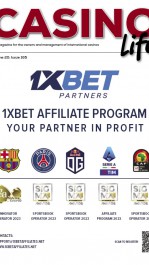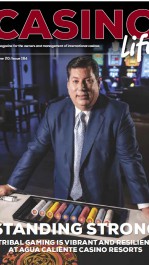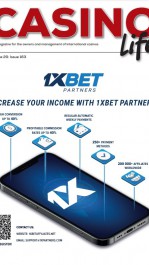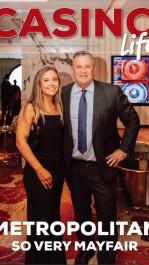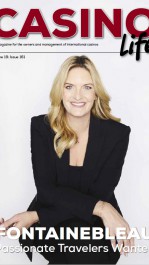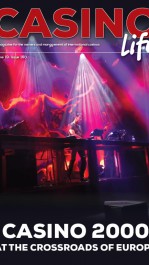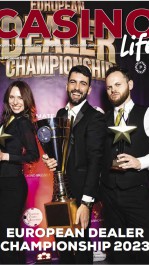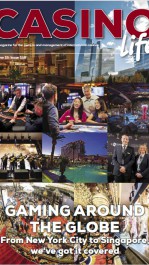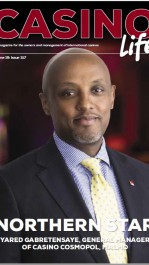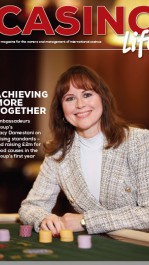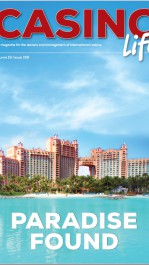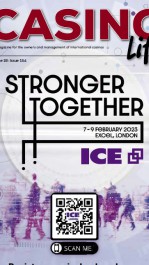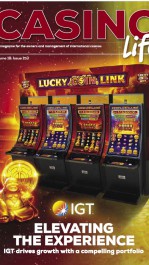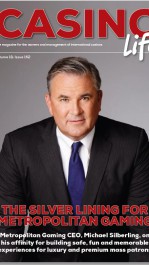
“Focus” is a word you’ll hear often in conversation with Pinnacle Entertainment CEO Anthony Sanfilippo. It’s his mantra for the company and it’s his operating philosophy. How many companies of Pinnacle’s stature would simply walk away from the application process for a New York State casino because it disrupted the focus of their integration of Ameristar Casinos into Pinnacle?
“We knew we would be, as it turned out, one of 22 companies putting in for four licenses,” Sanfilippo says. “We felt the distraction of going after a license was [less] important to focus on than the integration of Ameristar and Pinnacle Entertainment … there was not a better and higher use of our time than to focus on system integration, people integration and really get the value out of two companies of the same size coming together.”
In contrast to other companies that flail at every opportunity that comes down the pike, sometimes nonsensically, Pinnacle has picked its targets carefully. The Ameristar purchase, which just saw its first anniversary, is Sanfilippo’s signature achievement: The acquisition of a steady, solidly performing company – not a glamorous one but one that is not only remunerative but doubles the size of Pinnacle’s roster of properties.
The Pinnacle CEO, who joined the company in March 2010, replacing the volatile Dan Lee, is also pragmatic. When the Federal Trade Commission threatened to nix the Ameristar purchase unless Pinnacle sold one property each in St. Louis (where Pinnacle would have owned three) and in Lake Charles, Louisiana, Sanfilippo briefly resisted, then made the deal. Pinnacle’s most recent achievement has been to crack the Ohio market with its new racino, Belterra Park. It’s been slow out of the gate in its early months but Sanfilippo has a plan (see below) to turn things around.
The décor in Sanfilippo’s office is whimsical, and as low key as its occupant. A Jack Binion bobblehead sits behind his desk. A fortuneteller booth (refugee from a Pinnacle game arcade) and a life-size pirate figure face each other from opposite sides of the room. And a poster of a blue dog symbolizes the comeback of Louisiana – one of Pinnacle’s prime markets – from Hurricanes Katrina and Rita. Sitting at a side table, Sanfilippo fixes his penetrating but unthreatening gaze upon you and awaits the first question.
What made Ameristar, of all the companies you could have chosen, such an attractive takeover target?
They have some flagship properties. In the St. Louis area, St. Charles is a beautiful flagship property. In Kansas City it is by far the nicest property and Black Hawk is a terrific resort. In Vicksburg [it’s] by far the nicest property in the Vicksburg area.
Ameristar had a portfolio that was very similar to Pinnacle Entertainment’s. By that I mean the quality of the properties that were in the Ameristar portfolio, the markets that those properties were in. So it gave us new markets such as Council Bluffs, Black Hawk, East Chicago, Vicksburg … all of those were brand-new markets to us and Jackpot, Nevada gave us a property in Nevada. There wasn’t another gaming company that we felt was such a good fit. As we further explored Ameristar and spent time talking with the management, we soon saw that the company values were very similar. So it ended up being a really good cultural fit as well as the ability for us to more than double the size of Pinnacle Entertainment.

Why did you choose to retain the Ameristar brand? What made it worth keeping?
If you look at the length of time Ameristar had been in the markets they’re in … Vicksburg just celebrated its 20th anniversary. Ameristar in Kansas City and St. Charles have not been there as long but they’ve been there probably 15 years in the Ameristar brand. So there is tremendous equity in the name Ameristar in the markets that they operate. From a Pinnacle standpoint, Pinnacle Entertainment is our corporate name. We don’t have Pinnacle on any given property. We have a variety of brands that include L’Auberge. It includes River City, Belterra, Belterra Park, Boomtown. So there’s no one dominant brand and, in fact, the brands are each a little bit different. Our strategy is that we’re going to have one reward program that covers the whole company and we quickly implemented one, My Choice. It came from the Pinnacle program and we took what we thought was best-in-class from Ameristar’s loyalty program and of the Pinnacle legacy program and on April 1 we implemented, company-wide, one loyalty program. That’s how we tied the properties together.
Our program has five different tiers. The top one is the Owners Club and you’re able to receive a number of different things, starting with 100 shares of Pinnacle Entertainment stock. [We’re the] only company anywhere that I can find that, as part of their loyalty program, will give guests shares of company stock. We had to register those shares with the SEC and go through quite a process to be able to do that. Another feature is we provide you a vehicle – there’s four models you can choose from – from Mercedes Benz and it’s not their entry line. It’s a higher line than that where our guests can get one of four vehicles, which includes a sedan, a convertible or an SUV. All we require you to pay is the insurance. We’ll lease the vehicle for a year and then you pay your own personal insurance on it. We also have a relationship with Royal Caribbean Cruise Lines where we’ll give everyone who’s an Owner’s Club member a seven-day cruise. We also have a relationship with the Atlantis, in the Bahamas. We have a relationship with Tiffany’s. We have a relationship with Apple where we give you Apple products.
When the FTC decreed that two casinos would have to be sold, you were initially resistant but you reversed yourself. What changed your mind?
We were fully engaged with the Federal Trade Commission in trying to prove to them that each of those markets have additional casinos, that it wouldn’t create an unfair advantage. We thought there were other choices, very viable casino options that guests could go to but it was clear they were going to hold that position. We had until September the 20th to close this deal with Ameristar. If we didn’t close, then there would be an $85 million breakup fee that we would be required to pay. When we made the decision to go ahead and sell those two assets we made it because we had to find buyers; what the FTC required was that we have a buyer. Not that we closed on the deal but that we had a buyer for each property. So it was going to take time to hold discussions and run a process for other companies to buy those assets. Time was not on our side and the FTC was pretty adamant about their position. We made the decision that it was more prudent to tell the FTC that we would dispose of those assets and move on.
Describe the challenges of now having Lumiere Place and the soon-to-be Golden Nugget in Lake Charles as competitors.
Lumiere is a terrific property. It is anchored by a beautiful hotel, the Four Seasons, which we also had to sell. The properties that we have in St. Louis really serve different markets, which was our argument with the FTC. Lumiere serves the market that wants to go downtown, River City really serves more of the south-county market and Ameristar St. Charles serves a market that’s 30 minutes away from River City. It’s a good distance from River City. I still believe today that it’s big enough for those three. There are other [casinos] there and we focus, in both River City and St. Charles, on the population that sits immediately around that property. We continue that and I don’t see that the customer that goes downtown as the same customer that will go to River City or St. Charles.
With the Golden Nugget [in Lake Charles], Tilman Fertitta has done a terrific job with growing Landry’s. Landry’s is a significant company on its own and has a number of wonderful restaurants. They have over 70 in south Texas. They have great awareness there. We have worked in a competitive but friendly manner with them. We’re going to have a trolley that goes between both properties so we can give our guests the convenience of going between both properties easily. We’re building a boardwalk along the waterfront that will allow guests to walk between both properties. The walk is a fairly short walk. So we are working together. They’re building a golf course. There will be two beautiful golf courses side by side. We know that guests will go between both properties and now they’ll have a greater variety of restaurants to go to. There will be entertainment options at both properties. We have been very much friendly competitors with the Golden Nugget.
I believe that in the case of the Lake Charles property they’re going to have about 720 additional hotel rooms. We have a thousand rooms. We’re frequently sold out on the weekends. That will create a lot of people staying in a complex that’s connected via trolley, via walkway. We’ve approached it in that manner with them. I like the fact that they have a great reputation being a restaurant operator. Houston, we believe, is underserved. There’s many people who live in Houston who haven’t been to Lake Charles. Hopefully recognizing a restaurant brand that is there from the Golden Nugget may incent them to drive over to Lake Charles.

How have been the early results from Belterra Park?
Belterra Park, first and foremost, is a beautiful facility. We completely took the facility down to the ground. We moved slightly over, to give us more room, the dirt track and the turf track, and built an integrated racing and gaming facility. The awareness of Belterra Park is still at a pretty low level, not everybody knows it’s there in the marketplace. So we’re in the process right now of building a guest base that we’ll have over a long period of time. Same dynamic that went on with Baton Rouge, [which] is now going to be open two years on September 1. I felt like it took us between 12 months and 18 months to really build a good level of awareness that that property was there.
How do you differentiate the customer bases for Belterra Park and for the original Belterra down the road?
Belterra Resort, which is a full-service resort, 600 guest rooms, a golf course, a spa, is about an hour away. So we really focus on Belterra Park as a day trip. You want to come to Belterra Park for the day, it’s close to where you live. And Belterra Resort is much more focused on a one-to-two-night stay if you want to come to the spa, if you want to play golf. We’ve upgraded or redone all of our restaurants and we look at Belterra Resort as a destination resort with a casino.
I look at every one of our properties that we have and I don’t just see them as a casino. I see them as a hotel, as restaurants, as destinations that we look to say, ‘How do we maximize the profit potential of each one of our buildings?’ Belterra Resort is a terrific example. It’s a great resort and we run it like a resort. We realize that there is a lot of casino competition in [the] two-state area.
You’ve occasionally come under pressure from institutional investors to convert Pinnacle to a REIT. What are the pros and cons of that?
We probably don’t have enough time to go through the pros and cons of a REIT. We are still evaluating what they may be. Penn National, they converted to a REIT earlier this year, so our industry only has one example of it. From a chief executive officer, from a chief financial officer, it is our responsibility to continue to look at what are the ways that we can continue to create value for our shareholders and what’s the best platform to do that? We continue to look at that. There’s one example of a REIT that’s in our industry and it’s pretty early on: It’s in its first year. We frequently look at, long-term, what’s the best thing to do for Pinnacle Entertainment? To go beyond that as to what it means to be a REIT or not, it’s still very, very early on.
Although you’re headquartered in Las Vegas, there’s never been a whisper about Pinnacle acquiring or building in the Las Vegas market. Why not?
We foremost are, we believe, very good stewards of our shareholders’ investment. We are not driven by ego, we’re driven by what makes sense from a shareholder perspective. When you look at Las Vegas over the last five or six years, it’s been a market that has been under a lot of pressure just because of the recession. If we thought there was an opportunity here that would have the right economic value for Pinnacle Entertainment, then we would take a serious look at that.
Also, the location would be important because now we have 16 properties to feed into Las Vegas. But for that to happen you have to have a property or a product that’s available for the right price. So the reason you haven’t heard anything about us is the situation hasn’t come up that we were interested in enough that we thought would be a good fit for our portfolio.
Now, what we have done is, through our My Choice loyalty program, we have a relationship with MGM. By being a member of our My Choice loyalty program, the top three tier levels have a variety of [MGM] properties that they’re able to stay with here. So while we don’t have our own bricks and mortar in Las Vegas, we have a relationship with a wonderful, international company that takes great care of our guests when they come here.
In Pinnacle there are three things that we’re focused on. We’re making a decision that is based on what is in the interest of team members, what’s in the best interest of our guests and what’s in the best interest of our shareholders: ‘We think these decisions need to be in the best interests of one of the three or hopefully all three,’ if we’re not making a decision that’s focused on the best interest of one of the three, you’ve got to question why we’re doing it

.gif)
